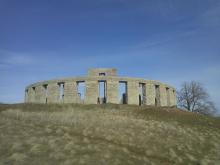Listen to today's episode of StarDate on the web the same day it airs in high-quality streaming audio without any extra ads or announcements. Choose a $8 one-month pass, or listen every day for a year for just $30.
You are here
Winter Solstice
Winter arrives in the northern hemisphere today — the winter solstice. The Sun is farthest south for the entire year, and it’s in view for the shortest time.
Over the millennia, many cultures have looked forward to the solstice. It marks the Sun’s turning point, and heralds longer, warmer days ahead. So people found ways to track the Sun’s motion along the horizon. They used alignments with hills or other features, or they built special “observatories.” And perhaps the most famous of those is Stonehenge, in England.
The first phase of Stonehenge was started about 5,000 years ago. It was a ditch with high banks that formed a big circle. About 500 years later, circles and horseshoes of stone were built inside that ring.
The main “avenue” aligns with the sunset point on the winter solstice. From the center of the ring, the Sun would have set inside the tallest “trilithon” — a pair of stones bridged by a third stone.
People gathered in that region at the solstice for feasting and other rituals. That suggests that the winter solstice was the most important time of the year at Stonehenge.
Several researchers have concluded that Stonehenge also had other astronomical alignments. There’s less evidence for those. But there’s strong evidence that Stonehenge helped the people of that region track the winter solstice — and celebrate the returning Sun.
And you can see Stonehenge right here in the U.S. More about that tomorrow.
Script by Damond Benningfield




